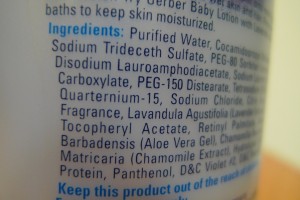
It's a topic well known to advocates, but perhaps surprise the average consumer--not all chemicals need to be listed on a product's ingredients labels. Worse, little research has been done on many chemicals, including those in common household products. Today, Forbes reports on a major peer-reviewed study in Environmental Health Perspectives--published by the National Institute for Environmental Health Sciences.
Researchers tested 213 products across 50 different categories, looking specifically at 66 chemicals associated with endocrine disruption or asthma. As Forbes reports:
The study included both conventional products, such as Windex original glass cleaner and Irish Spring deodorant soap, as well as “alternative” products marketed as containing safer ingredients than their conventional counterparts, such as Seventh Generation Free and Clear natural glass and surface cleaner and Tom’s of Maine natural moisturizing body bar. Lab tests detected 55 chemicals of concern–including parabens, phthalates, bisphenol A (BPA), antimicrobials, cyclosiloxanes, glycol ethers, and fragrances–in the conventional product samples tested and also found 41 concerning chemical compounds in all but 11 alternative products. Very few of these chemicals were included on product labels.
The Silent Spring Institute funded the study. In its press release, the Institute listed the following findings as being especially important:
- Vinyl products, such as shower curtains and pillow protectors, contain more than 10% by weight of the phthalate DEHP, an endocrine disruptor (anti‐androgen) that has also been associated with increased respiratory symptoms in some studies.
- Fragranced products – including air fresheners, dryer sheets, and perfume – and sunscreens had the largest number of target chemicals and some of the highest concentrations. Fragrances can trigger asthma and some have been shown to mimic estrogen, including making breast cancer cells grow in laboratory studies.
- In addition to the labeled ingredients, alternative sunscreens contained up to 7 target chemicals that were unlabeled, including estrogenic UV filters. The alternative sunscreen with the highest number of target chemicals was a product marketed for babies, children, and sensitive adults.
- A consumer who used the tested alternative surface cleaner, tub and tile cleaner, laundry detergent, bar soap, shampoo and conditioner, facial cleanser and lotion, and toothpaste would be exposed to 19 of the target compounds.
Sunscreens? Bar soap? Shampoo? You might think that these are the very products which are heavily regulated, but no.
In the study, the researchers spotlight the limited regulation by the Food and Drug Administration around labeling of ingredients. Many regulations for consumer products were last updated more than 40 years ago. For cosmetics, while the word "fragrance" must be labelled, the individual chemicals of a fragrance and "incidental ingredients" do not need to be itemized. The terms "natural," "non-toxic" and "green" are unregulated, the researchers say. Another study looked at "green" labelled fragranced products and found that "VOC"s--volatile organic compounds--were just as plentiful in the "green" products than in those products not labelled "green." (I liked the title of that study, "Scented Products Emit a Bouquet of VOCs."